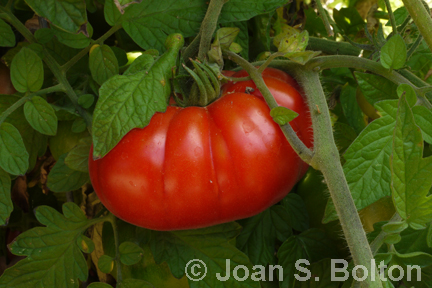
The perfect tomato.
It may be round and red, with a thick slice providing a juicy, sun-ripened complement to a sandwich or burger.
It may be pear-shaped and yellow, and pack a crisp punch in a salad of fresh greens.
It may be oval, flushed with pink and just meaty enough to create a thick sauce.
Or it may be a sweet, marble-sized orb that’s so delicious that you lose count of how many you pop into your mouth, still out in the garden.
Really, there is no one perfect tomato. Instead, there are literally dozens, any of which may be perfect at a particular moment.
And fortunately, despite those many colors, shapes and sizes, all tomatoes thrive with the same care. Success starts with good soil, good roots and plenty of sunshine. Add proper watering, and you’re on your way to as many perfect tomatoes as you can squeeze into your space.
Getting Growing
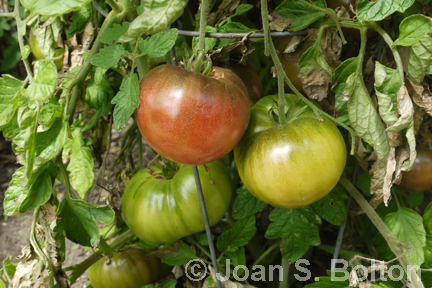
Start with rich, loose, well-draining soil in a spot that receives at least six hours of direct sunlight a day.
Raised beds or mounds at least 12 to 18 inches tall are ideal.
Dig down a foot, working in several inches of well-aged compost throughout the bed to boost fertility and drainage.
Tomatoes are a rarity in that you can intentionally plant them deep to encourage more extensive rooting.
Strip the first few sets of leaves. Dig a hole deep enough to bury the exposed nodes, which will then sprout roots, rather than more leaves. Toss a low-nitrogen, slow-release granular fertilizer into each hole. Cover the fertilizer with a handful of soil to prevent direct contact with the roots.
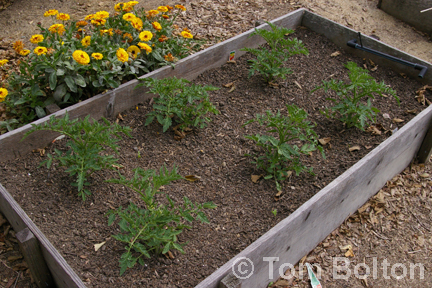
Then space your plants at least 2 1/2 feet apart.
Plums and cherries may go closer, while the largest plants should go 3 feet apart or more.
Tomato cages or stakes — adorned with reflective tape to thwart birds — are a must. I often start with tomato cages, then pound in taller redwood stakes mid-season.
Even the smallest plants need support when their limber branches begin to sag under the weight of developing fruit.
Consistency is Key
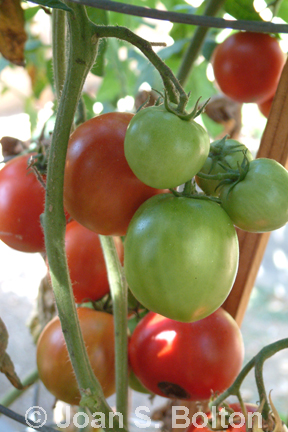
Irrigation can be tricky. It should be consistent in order to prevent blossom end rot, an unsightly condition that damages the fruit, yet infrequent enough to tease out the most intense, fresh flavors by the time your tomatoes are ripe.
At the outset, water every day or two to keep the soil visibly damp. I shape basins around my plants, then fill the basins several times each time I water. I use a watering wand to avoid splashing the leaves, which can lead to disease. If your soil crusts or cracks, surround your seedlings with an inch-thick layer of loose mulch.
As new leaves flush out and shade the roots, stretch your watering intervals to every three or four days, then up to a week or even 10 days, still giving a good soak each time. Let the top inch of soil dry out between waterings. Irrigate early in the morning to help the plants stay hydrated in the summer heat.
If you see fantastic vegetative growth but few flowers and weak, watery-tasting fruit, you’re watering too frequently. But don’t stop abruptly. A sudden change in irrigation can disrupt your plants’ ability to pull calcium from the soil, which can result in that dreaded blossom end rot.
So Many Choices
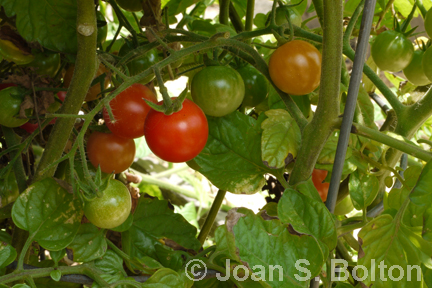
Local nurseries, seed catalogs, internet sites and even drugstores are brimming with tomatoes in springtime. Rather than grabbing the first six-pack you see, consider the size, shape and color, as well as whether you want to eat your tomatoes fresh, in sauces or canned for winter.
Most will be indeterminate types, which send out long vines that keep growing and bearing fruit until frost kills them off. Determinate types, or bush tomatoes, reach a certain size, bear most of their fruit within a couple of weeks, then collapse. They’re worth seeking out if you want to can or preserve your tomatoes all at once.
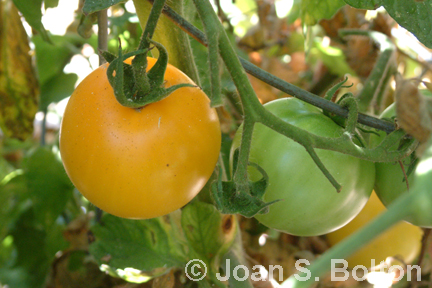
Hybrid tomatoes are modern varieties bred for certain traits and disease resistance. “V,” “F,” “N” and “T” indicate resistance to verticillium wilt, fusarium wilt, nematodes and tobacco mosaic virus, all of which can slay your plants. Super Bush VFN tomatoes, for instance, resist verticillium wilt, fusarium wilt and nematodes.
However, due to breeding, hybrids are not true to seed, and hybrid offspring are not likely to resemble their parents.
Heirlooms, on the other hand, have been passed down from one generation to the next and are true to seed. While heirlooms may not have as strong disease resistance as modern hybrids, they tend to have greater variety in shape and color, and softer skins.
≈
This article was first published in the Spring 2012 issue of Central Coast Farm & Ranch.
Copyright, Joan S. Bolton. All rights reserved. Reproduction of text or photos in any form is prohibited without written permission.
≈
